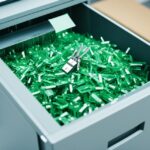Digital File Shredding: Ensuring Complete Data Erasure
When it comes to protecting your digital privacy and ensuring the complete erasure of sensitive data, digital file shredding is essential. Simply deleting files or formatting a drive is not enough to permanently destroy the data. Shredding digital files involves overwriting the data with a pattern of 0s and 1s, making it almost impossible to recover. To achieve effective file shredding, it’s important to use a secure data erasure software that implements international data erasure standards, such as DoD 5220.22-M.
One recommended tool for digital file shredding is Stellar File Eraser, which features three international data erasure standards including DoD. By using a file shredder software like Stellar File Eraser, you can guarantee that your digital files are destroyed beyond recovery.
With the increasing prevalence of data breaches and privacy concerns, it’s crucial to prioritize the security of your digital information. Shredding your digital files ensures that no trace of sensitive data remains, giving you peace of mind and protecting your digital privacy.
In the following sections, we will explore the importance of digital file shredding, different methods of data destruction, the significance of shredding hard drives and digital media, data privacy laws in Canada, and how digital file shredding can enhance overall data security.
The Importance of Shredding Digital Files
Simply deleting files or emptying the Recycle Bin does not permanently erase sensitive data from your digital devices. This data can still be easily recovered using data recovery software. To ensure that your files are gone beyond recovery, it is crucial to shred them. Shredding digital files involves overwriting the data with a pattern of 0s and 1s, making it almost impossible to recover.
Most file shredding software uses a basic pattern of 0s and 1s, which may not effectively destroy files beyond recovery. To achieve complete data erasure, it is important to use a file shredding tool that implements international data erasure standards, such as DoD 5220.22-M or Gutmann. By shredding your digital files with a secure and reliable tool like Stellar File Eraser or BitKiller, you can ensure that your sensitive data is destroyed beyond recovery, providing you with peace of mind and protecting your digital privacy.
“Simply deleting files or emptying the Recycle Bin does not permanently erase sensitive data from your digital devices.”
Shredding your digital files is essential for several reasons:
- Protecting your personal or business data from being accessed by unauthorized individuals.
- Preventing data breaches and safeguarding your sensitive information.
- Ensuring compliance with data privacy regulations.
- Maintaining the trust and confidence of your customers and clients.
By securely shredding your digital files, you can take proactive steps to mitigate the risk of data theft or unauthorized access. This is especially important in today’s digital landscape, where cybercriminals are constantly finding new ways to exploit vulnerabilities and steal valuable information.
Remember, digital file shredding is not just limited to personal computers and laptops. It is equally essential to shred files on other digital devices such as smartphones, tablets, external hard drives, and USB drives. These devices contain a wealth of sensitive data that can be accessed if not properly shredded.
Implementing secure data erasure practices, including digital file shredding, should be a fundamental part of your data security strategy. By taking this proactive approach, you can protect your digital privacy, prevent data breaches, and ensure compliance with data privacy laws and regulations.
| Benefits of Shredding Digital Files | Protects sensitive data from unauthorized access | Prevents data breaches | Ensures compliance with data privacy regulations |
|---|---|---|---|
| Peace of mind and security | Safe and secure disposal of sensitive information | Reduces the risk of identity theft | Preserves the trust of clients and customers |
| Effective data protection | Prevents the recovery of deleted files | Protects intellectual property and sensitive business information | Avoids potential legal and financial consequences |
| Comprehensive privacy | Guarantees the complete destruction of digital files | Eliminates the risk of data breaches caused by residual data | Allows for secure recycling or disposal of devices |
Methods of Data Destruction
When it comes to securely disposing of sensitive data, there are several methods of data destruction to consider. Each method has its own advantages and disadvantages, so it’s important to choose the most appropriate one based on your needs.
Methods Overview
- Deletion: This method simply removes files from their folders, but the data remains on the hard drive and can be easily recovered.
- Data Wiping: Data wiping erases data from the device itself, making it unrecoverable. However, it can be a time-consuming process.
- Data Overwriting: Data overwriting replaces existing data with a string of 1s and 0s, reducing the data to gibberish. However, residual data may still be viewable with an electron microscope.
- Degaussing: Degaussing destroys the magnetic field in a hard drive, making it unusable. However, verification requires an electron microscope.
- Physical Destruction: Physical destruction involves physically breaking the storage device, rendering both the data and the device itself unusable.
- Data Shredding: Data shredding is the most secure and cost-effective method. It involves shredding the storage device into tiny fragments, ensuring complete data erasure.
Comparison Table
| Method | Advantages | Disadvantages |
|---|---|---|
| Deletion | – Quick and easy – Does not require additional equipment | – Data can be easily recovered – Residual data remains on the drive |
| Data Wiping | – Makes data unrecoverable – Can be done on the device itself | – Time-consuming – Requires specialized software |
| Data Overwriting | – Reduces data to gibberish – Can be done with software | – Residual data may be viewable with an electron microscope |
| Degaussing | – Destroys magnetic field in hard drive – Ensures data is unrecoverable | – Verification requires an electron microscope |
| Physical Destruction | – Renders device and data unusable – Provides visual confirmation of destruction | – Requires the use of dedicated equipment – May not be environmentally friendly |
| Data Shredding | – Most secure method – Cost-effective – Ensures complete data erasure | – Requires specialized equipment |
Considering the strengths and limitations of each method, data shredding emerges as the most secure and cost-effective option for businesses dealing with high-security material. By shredding storage devices into tiny fragments, data shredding guarantees complete data erasure, providing businesses with peace of mind and minimizing the risk of data breaches.
Shredding Hard Drives for Data Erasure
Hard drives are prime targets for data theft, and simply deleting files or formatting the drive is not enough to ensure complete data erasure. Shredding hard drives is the safest course of action to prevent data breaches and protect sensitive information.
Shredding companies like Shred Station offer secure hard drive shredding services, both onsite and offsite. Onsite hard drive shredding allows you to witness the destruction of your drives, while offsite shredding takes place at state-of-the-art plants.
During the shredding process, hard drives are destroyed into small fragments, ensuring that the data cannot be retrieved. Shredding hard drives is essential for individuals, small businesses, and corporate giants alike to safeguard their data and comply with data privacy laws. It provides peace of mind and protects both businesses and their customers from potential data breaches or identity theft.
| Hard Drive Shredding Providers | Onsite Shredding | Offsite Shredding |
|---|---|---|
| Shred Station | Yes | Yes |
By choosing a trusted hard drive shredding provider like Shred Station, individuals and businesses can ensure the secure destruction of their data. Whether it’s personal information or confidential business data, shredding hard drives is a critical step in data protection and disposal.
The Process of Digital Media Destruction
Digital media destruction plays a crucial role in securely disposing of items that contain confidential data. To ensure the protection of sensitive information, it is essential to destroy various digital media, including optical disks (CDs and DVDs), removable storage (USB drives, SD cards, and compact flash cards), solid-state drives, microfilm, audio and backup tapes, floppy disks, and even old VHS tapes. By securely destroying these devices, businesses can prevent data breaches and comply with data privacy regulations.
Secure destruction can take place either onsite or offsite. Onsite destruction allows you to witness and verify the destruction process, providing an extra layer of assurance. Offsite destruction, on the other hand, occurs at secure facilities equipped with industrial media and hard disk shredder machines. These machines ensure quick and thorough destruction of the data, reducing the risk of any potential data recovery.
In addition to individual digital media, full PCs and laptops can also be collected and disposed of in accordance with IT disposal and recycling requirements. This ensures that all components containing sensitive data are effectively destroyed and disposed of in an environmentally friendly manner.
It is crucial to separate digital media designated for shredding from paper to maximize the recycling opportunities. By following proper digital media destruction protocols, businesses not only protect their sensitive information but also contribute to sustainable waste management practices.
| Digital Media | Destruction Method |
|---|---|
| Optical disks (CDs and DVDs) | Shredding |
| Removable storage (USB drives, SD cards, and compact flash cards) | Shredding |
| Solid-state drives | Shredding |
| Microfilm | Shredding |
| Audio and backup tapes | Shredding |
| Floppy disks | Shredding |
| Old VHS tapes | Shredding |
By prioritizing digital media destruction, businesses can effectively safeguard their sensitive information, mitigate the risk of data breaches, and comply with data privacy regulations.
Data Shredding and Data Privacy Laws in Canada
In Canada, businesses are required to implement protocols for the proper disposal of sensitive information to minimize the risk of security breaches. The Personal Information Protection and Electronic Documents Act (PIPEDA) regulates the collection, use, and disclosure of private information for commercial purposes. PIPEDA places the responsibility on businesses to properly destroy personal information that is no longer required to fulfill identified purposes. The Privacy Act of 2019 outlines a citizen’s right to access and revise their personal information held by Canadian government institutions and agencies. Compliance with data privacy laws is essential for businesses to protect both themselves and their customers. Data shredding is the most efficient and cost-effective way to remove old data and ensure compliance with Canadian data privacy regulations.
| Canadian Data Privacy Laws | Key Points |
|---|---|
| Personal Information Protection and Electronic Documents Act (PIPEDA) | – Regulates collection, use, and disclosure of private information for commercial purposes – Businesses must properly destroy personal information no longer required – Ensures businesses protect customer data |
| Privacy Act of 2019 | – Provides individuals with the right to access and revise their personal information held by Canadian government institutions and agencies – Protects citizens’ privacy – Encourages transparency and accountability |
Complying with data privacy laws is not only a legal responsibility but also crucial for maintaining trust and reputation. By implementing proper data shredding practices, businesses can securely dispose of sensitive information and prevent unauthorized access. Data shredding involves systematically destroying data in a way that makes it virtually impossible to recover. This ensures that old data, whether stored electronically or physically, is permanently erased and cannot be misused.
Data shredding offers a number of benefits for businesses:
- Protects sensitive information from falling into the wrong hands
- Reduces the risk of data breaches and identity theft
- Ensures compliance with data privacy laws
- Helps build customer trust and confidence
- Reduces storage costs by disposing of unnecessary data
By partnering with a trusted data shredding provider such as DOCUDavit, businesses in Canada can securely destroy sensitive information and meet their legal obligations. DOCUDavit specializes in providing secure data shredding solutions that adhere to Canadian data privacy regulations. With their expertise and state-of-the-art technology, businesses can have peace of mind knowing that their sensitive data is being securely managed and destroyed.
Data shredding in Canada plays a crucial role in safeguarding sensitive information and ensuring compliance with data privacy laws. By following proper protocols and partnering with trusted providers, businesses can protect themselves and their customers from data breaches and uphold the highest standards of privacy.
Ensuring Data Security with Digital File Shredding
In today’s digital landscape, data security is of utmost importance, given the prevalence of data breaches and privacy concerns. To protect sensitive data, simply deleting files or formatting drives is not sufficient. That’s where digital file shredding comes into play. By implementing international data erasure standards, such as DoD 5220.22-M, and using a secure data erasure software, individuals and businesses can ensure the complete destruction of their digital files, leaving no trace behind.
Shredding hard drives and other digital media is an essential step in safeguarding against data theft and complying with data privacy laws. While there are various methods available for data destruction, such as deletion, wiping, overwriting, degaussing, and physical destruction, data shredding stands out as the most secure and cost-effective option. By shredding digital files, the data is overwritten with a pattern of 0s and 1s, making it nearly impossible to recover. This eliminates the risk of sensitive information falling into the wrong hands.
By prioritizing data security and incorporating digital file shredding into their data management practices, businesses can not only protect their sensitive information but also safeguard their reputation. Ensuring compliance with data privacy regulations is becoming increasingly crucial. By adopting proper data destruction measures like digital file shredding, organizations can demonstrate their commitment to protecting customer data, enhance their overall security posture, and contribute to the peace of mind of their stakeholders.
FAQ
What is digital file shredding?
Digital file shredding is the process of permanently destroying data by overwriting it with a pattern of 0s and 1s, making it almost impossible to recover.
Why is digital file shredding important?
Simply deleting files or formatting a drive is not enough to ensure complete data erasure. Digital file shredding guarantees that sensitive data is destroyed beyond recovery, protecting your privacy.
What are the different methods of data destruction?
There are several methods of data destruction, including file deletion, data wiping, data overwriting, degaussing, physical destruction, and data shredding.
Why should I choose data shredding?
Data shredding is the most secure and cost-effective method of data destruction. It involves shredding the storage device into tiny fragments, ensuring that the data cannot be retrieved.
How does hard drive shredding work?
During the hard drive shredding process, hard drives are destroyed into small fragments, making the data unrecoverable. This guarantees the complete destruction of sensitive information.
What is the process of digital media destruction?
Digital media destruction involves securely destroying devices such as optical disks, removable storage, solid-state drives, microfilm, audio and backup tapes, floppy disks, and VHS tapes. This is done using industrial media and hard disk shredder machines.
What are the data privacy laws in Canada related to data destruction?
In Canada, businesses are required to comply with data privacy laws such as the Personal Information Protection and Electronic Documents Act (PIPEDA) and the Privacy Act. Proper data shredding is essential to ensure compliance with these regulations.
How does digital file shredding contribute to data security?
Digital file shredding ensures data security by permanently destroying sensitive information, protecting against data breaches, and complying with data privacy laws.















